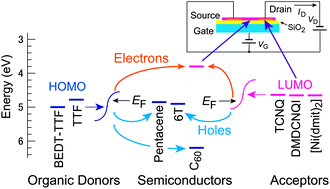Charge injection from organic charge-transfer salts to organic semiconductors†
Abstract
Highly conducting films of organic charge-transfer (CT) salts are fabricated by a solution process from the dispersions stabilized by

* Corresponding authors
a
Department of Organic and Polymeric Materials, Tokyo Institute of Technology, 2-12-1 O-okayama, Meguro-ku, Tokyo, Japan
E-mail:
mori.t.ae@m.titech.ac.jp
Fax: +81-3-5734-2427
Tel: +81-3-5734-2427
b CNRS, Laboratoire de Chimie de Coordination, 205, route de Narbonne, Toulouse cedex 04, France
c Université de Toulouse, UPS, INPT, LCC, Toulouse, France
Highly conducting films of organic charge-transfer (CT) salts are fabricated by a solution process from the dispersions stabilized by

 Please wait while we load your content...
Something went wrong. Try again?
Please wait while we load your content...
Something went wrong. Try again?
T. Kadoya, D. de Caro, K. Jacob, C. Faulmann, L. Valade and T. Mori, J. Mater. Chem., 2011, 21, 18421 DOI: 10.1039/C1JM12783G
To request permission to reproduce material from this article, please go to the Copyright Clearance Center request page.
If you are an author contributing to an RSC publication, you do not need to request permission provided correct acknowledgement is given.
If you are the author of this article, you do not need to request permission to reproduce figures and diagrams provided correct acknowledgement is given. If you want to reproduce the whole article in a third-party publication (excluding your thesis/dissertation for which permission is not required) please go to the Copyright Clearance Center request page.
Read more about how to correctly acknowledge RSC content.
 Fetching data from CrossRef.
Fetching data from CrossRef.
This may take some time to load.
Loading related content
